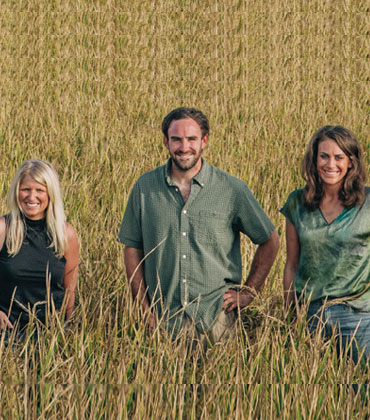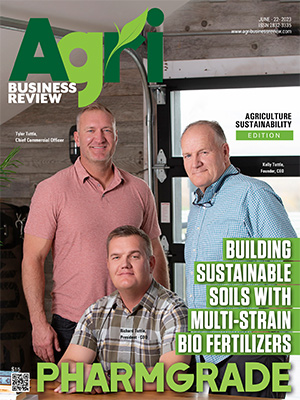The agricultural revolution was a turning point in human history that paved the way for the establishment of settlements and the creation of civilization. Today, 40 percent of the planet is farmland. However, as the population grows, the question of how to sustainably feed everyone is becoming increasingly pressing. One food producer, Two Brooks Farm, is leading the way in this effort using ecological farming methods.
Two Brooks Farm is a prime example of sustainable and ecological farming methods, specializing in non-GMO grade three soybeans and rice, including regular long-grain, basmati, jasmine, black, and red rice.
The farm operates a rice mill on its premises, creating a one-stop shop for multiple varieties. Its sustainability goal focuses on getting the most out of the land without depleting resources like water, synthetic fertilizers, and herbicides.
“We are dedicated to ensuring the products you purchase have the lowest possible impact on our planet’s resources and society. Our ecologically grown rice is cultivated in a symbiotic and biologically dynamic environment, minimizing its ecological, carbon, and water footprint while maintaining high production and quality standards,” says Lawrence Wagner, CEO of Two Brooks Farm. The farm has also recently started growing sushi and Arborio rice varieties.
Two Brooks Farm works tirelessly to keep the land use per calorie and resource cost per calorie generated low. Its innovative production and processing system gives it the leverage to achieve this goal.
The lead generation farmers, whose family has a tenth generation of farmers, have carefully studied the soil and practices on their tract of land to find the best rotation for their operation. This is unique in the Southeast region. The farm also has large drainage ditches, which they recycle water with—a practice they have been doing for years, long before the government incentivized it.
Precision zero grading and flooding throughout the year have improved crop production and attracted waterfowl, providing natural macronutrients and nitrogen for the next rice crop. Leaning on this expertise and the ‘work in harmony with nature’ model, Two Brooks Farm has reduced its nitrogen inputs by 40 percent while maintaining a similar yield to conventional farms. It uses no pesticides or fungicides and employs no-till and cover crops during the off-season to maintain soil health and give back to the land.
Doing this, the farm offers transparency and traceability to its customers, who know exactly where the rice comes from and how it has been grown, enhancing the farm-to-table concept. This transparency allows them to trust the source and quality of the food they purchase.
Two Brooks Farm’s practices are based on Low Input Sustainable Agriculture (LISA), which focuses on using only the necessary resources to produce a crop. This tactic was passed down by Mike Wagner, founder, who learned about it in college and found it to be the most logical method to deal with the uncertainty of weather and other conditions. This methodology allows it to produce good crops while spending less money and not pushing the boundaries of resources for higher yields.
Ecological farming is a sustainable and environment-friendly approach to agriculture that uses natural processes and resources to promote crop growth and health. Two Brooks Farms is a fitting example of how this approach can be successfully implemented in modern agriculture while augmenting the idea of ecological farming. By embracing these principles, the farm contributes to preserving the environment for future generations. It is as the Former U.S. Secretary of State Daniel Webster says, “When tillage begins, other arts follow. The farmers, therefore, are the founders of human civilization.”
Two Brooks Farm is a prime example of sustainable and ecological farming methods, specializing in non-GMO grade three soybeans and rice, including regular long-grain, basmati, jasmine, black, and red rice.
The farm operates a rice mill on its premises, creating a one-stop shop for multiple varieties. Its sustainability goal focuses on getting the most out of the land without depleting resources like water, synthetic fertilizers, and herbicides.
“We are dedicated to ensuring the products you purchase have the lowest possible impact on our planet’s resources and society. Our ecologically grown rice is cultivated in a symbiotic and biologically dynamic environment, minimizing its ecological, carbon, and water footprint while maintaining high production and quality standards,” says Lawrence Wagner, CEO of Two Brooks Farm. The farm has also recently started growing sushi and Arborio rice varieties.
Two Brooks Farm works tirelessly to keep the land use per calorie and resource cost per calorie generated low. Its innovative production and processing system gives it the leverage to achieve this goal.
The lead generation farmers, whose family has a tenth generation of farmers, have carefully studied the soil and practices on their tract of land to find the best rotation for their operation. This is unique in the Southeast region. The farm also has large drainage ditches, which they recycle water with—a practice they have been doing for years, long before the government incentivized it.
Precision zero grading and flooding throughout the year have improved crop production and attracted waterfowl, providing natural macronutrients and nitrogen for the next rice crop. Leaning on this expertise and the ‘work in harmony with nature’ model, Two Brooks Farm has reduced its nitrogen inputs by 40 percent while maintaining a similar yield to conventional farms. It uses no pesticides or fungicides and employs no-till and cover crops during the off-season to maintain soil health and give back to the land.
Our ecologically grown rice is cultivated in a symbiotic and biologically dynamic environment, minimizing its ecological, carbon, and water footprint while maintaining high production and quality standards
Two Brooks Farm’s practices are based on Low Input Sustainable Agriculture (LISA), which focuses on using only the necessary resources to produce a crop. This tactic was passed down by Mike Wagner, founder, who learned about it in college and found it to be the most logical method to deal with the uncertainty of weather and other conditions. This methodology allows it to produce good crops while spending less money and not pushing the boundaries of resources for higher yields.
Ecological farming is a sustainable and environment-friendly approach to agriculture that uses natural processes and resources to promote crop growth and health. Two Brooks Farms is a fitting example of how this approach can be successfully implemented in modern agriculture while augmenting the idea of ecological farming. By embracing these principles, the farm contributes to preserving the environment for future generations. It is as the Former U.S. Secretary of State Daniel Webster says, “When tillage begins, other arts follow. The farmers, therefore, are the founders of human civilization.”
Company : Two Brooks Farm
Headquarters :
Sumner, MS ManagementSarah Wagner, Manager, Lawrence Wagner, CEO, Abbey Wagner, CEO
Thank you for Subscribing to Agri Business Review Weekly Brief



